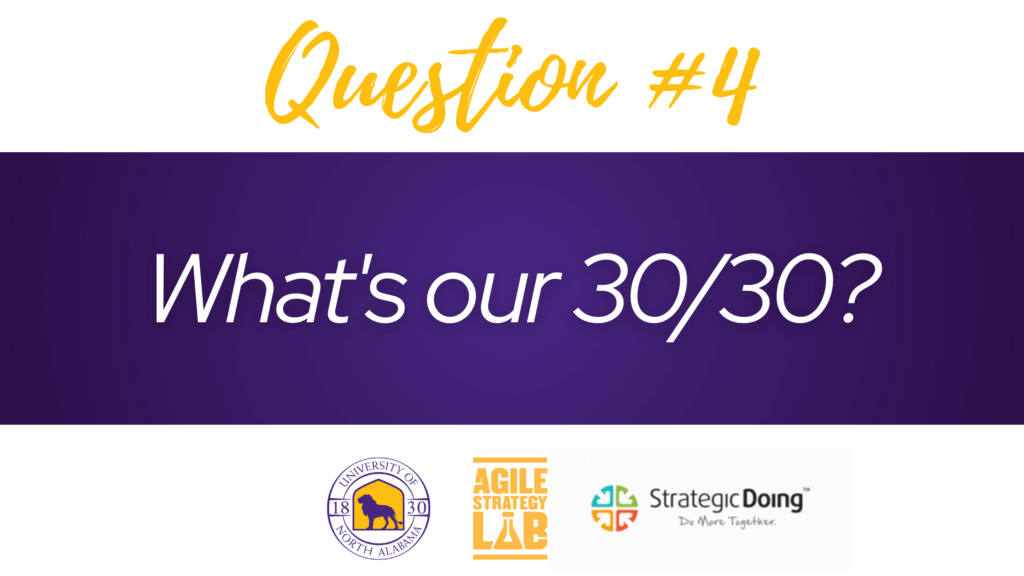What’s our 30/30? …Welcome to the future
This is week 12 of our 14-week series about the 4 Questions and 10 Rules of Strategic Doing outlined in our original blog from 2023.

We’ve arrived at the last of the four questions. The first three (“What could we do?”, “What should we do?”, “What will we do?”) are ones that can be answered in as little as a few hours in a Strategic Doing workshop, or over a series of conversations with an emerging group of co-laborers. The last question is phrased in Strategic Doing-ese as “What’s our 30/30?” A more universal rephrasing might be “What are we doing to maintain momentum?” It’s preparing us for the future.
In our workshops, we sometimes point out that the first three questions (or the first 8 rules/skills) of Strategic Doing make for a great meeting. People leave with a sense of accomplishment, of getting away from a habit of talking but not getting anywhere. That’s a valuable emotion, its own asset in some ways. But in order not to squander it, we have to ask the question of how we make that change permanent. Essentially, “How are we making sure this doesn’t die?”

We’ll be making plans for the future – however long that future turns out to be, depending on the challenge the group’s working on. It could be 60 days for an ad hoc team with a limited problem to solve, or it could be like Shoals Shift with more than a decade of co-creating something new in that part of Alabama.
The term 30/30 is based on having a 30 minute meeting every 30 days to revisit your plans and strategies. However, the when and where isn’t relevant quite yet – though we will be exploring that further in our upcoming posts. Before any of that, this question requires for us to choose to have a certain mindset, and over time (probably) persuade the rest of our team to share that mindset.
Getting into a future-forward mindset
There are two important aspects of this mindset, that are contradictory at first glance:
It’s appreciative. In other words, we’re pointing to what we’re driving toward, not fixing old problems that got us here (however, there will be time to fix issues that remain problems). We stay optimistic that maintaining momentum is possible. Sometimes, to stay oriented you might need to revisit Rule #2, and ask another framing question.
It commits to learning from setbacks. Sometimes when we’ve made it to this step in the process, we think ‘we’ve got this’, ‘we found the answer’,’ now we have a well-oiled machine that we just need to keep running.’ And we are almost certainly wrong – sooner or later, the environment will change or we’ll discover that one of our assumptions was wrong. We’re better off assuming that’s true from the beginning and keeping our eyes open so we recognize it quickly.
How to use this question
Start now. Don’t wait until later – build a plan early for how to sustain momentum after your first solution is in place . Make sure your core team (or at least a few of them) is committed to staying the course. Keep your eyes open for new talent to replace people that need to step back.
Put learning first. Many of our standing meetings become versions of everyone sharing “what I did this month.” Change that to everyone sharing “what I learned this month.” It’s a habit that builds accountability and makes meetings a draw, not a chore.
Create routines. Decide how (and what) information will be shared and how often you’ll gather, and stick to it. Don’t revisit your solutions until it’s clear that a change needs to be made.
Action step: Look at your calendar and identify one of those meetings that’s become a rote recitation of activity. If you lead it, let people know that you’ll be easing into a change and that they should come up with something they’ve learned to share with the group. Not your meeting? You can start the trend. If you can, go first in sharing and add your learning to your report.
Learn more: this idea of maintaining momentum is the subject of plenty of books, videos, and podcasts. Tune in to Guy Kawasaki talking to author Dan Heath about his work (much of which revolves around this topic.

Liz shepherds the expansion of the Lab’s programming and partnerships with other universities interested in deploying agile strategy tools. A co-author of Strategic Doing: 10 Skills for Agile Leadership, she also focuses on the development and growth of innovation and STEM education ecosystems, new tool development, and teaching Strategic Doing.
